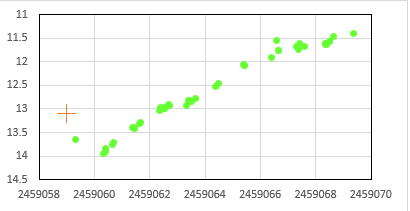An ATel written by Steve Shore from the spectra gathered in the database:
http://www.astrosurf.com/aras/Aras_Data ... as2020.htm
http://www.astronomerstelegram.org/?read=13939
ATel #13939; Steven N. Shore (Univ. di Pisa), Christophe Boussin, David Boyd, Christian Buil, Tim Lester, Jacques Michelet, Peter Somogyi (ARAS Group)
on 12 Aug 2020; 15:32 UT
We report the results of our continuing optical low and medium resolution spectroscopic monitoring of Nova Cas 2020 . We cover the interval reported in ATel #13903, #13905, #13919 and now extend it through Aug. 10. The spectra cover the period from 2020 Jul. 30.7 UT to Aug 11.9 UT with resolutions from 500 to 11000 in the spectral window 3700-8700A, exposure times of 1800 to 13000 sec, and S/N ranging from a low of about 20 to about 100 (peak line fluxes). The O I 7773A multiplet showed P Cyg profiles from the first spectra on Jul. 30.8. From Aug. 1.8 on, Fe II 5018, 5169 and other optical Fe II transitions showed P Cyg profiles. Aug. 8.3, the Ca II IRT showed weak emission, while O I 7773, 8446A both displayed P Cyg profiles (with absorption depths of around 60% and 25%, respectively), similar to the Pa series. The 7773A multiplet absorption was complex and broad, centered around -180 km/s but extending to nearly -500 km/s with emission extending to +300 km/s. On Aug. 4.9, blueshifted absorption appeared on the Na I D1,D2 lines at -190 km/s with an equivalent width EW = 0.1A. The absorption radial velocity was the same as all other P Cyg absorption on all Fe II lines (especially 5018, 5169A). On Aug. 6.8 the absorption had increased to EW = 0.5A with no change in radial velocity. The metal line absorptions displayed consistently lower radial velocity than the Balmer lines, whose asymmetric absorptions were deepest (Halpha, -250 km/s; Hbeta, -210) while extending to about -620 km/s; the emission to absorption equivalent width ratios were 3.8 (Halpha), 1.1 (Hbeta). Several blueshifted low ionization metal absorbers, e.g. Mg II 4481, Ti II 4764, and Si II 6347, 6371A, were present on Aug. 4 through Aug. 6 and persisted but were not well resolved in the later spectra. The Si II doublet showed weak emission through Aug. 6. There is a complex spectrum of weaker metal lines, all at low velocity, and the development of this nova shows similarities to nova DN Gem 1912 (McLaughlin 1965,POMic,9,113). No evidence was found of He I 5876, 6678, 7065 in any spectrum; on Aug. 11.9 the flux upper limit for He I 5876A emission was < 1.2E-15 erg cm-2 s-1 (uncorrected for extinction). As reported in Atel #13905, the interstellar DIBs are relatively strong including 5780 (EW=0.57A), 5793 (0.3A), and 6613A (0.37A). Based on the velocity range of the interstellar Na I D components (V(LSR)=-46,-9 km/s, ) and the width of the profile, 140 km/s, the LAB survey (
http://adsabs.harvard.edu/abs/2005A%26A...440..775K) gives a total N(H)=8.2E21/cm^2. The H I displays a higher velocity, -65 km/s (mean), than the Na I components so this is a likely upper limit to the line of sight extinction. In light of the still rising optical flux and the lack of any forbidden lines (including [O I]), the nova may be a case of a highly inclined aspherical ejecta still in the optically thick stage with the initiation of the recombination wave known from other novae in the pre-maximum stage. Observations are continuing, the spectra are available at the ARAS Nova Database.
Steve comments:
this will be a nova to keep following and will surely lead to a paper (especially if there's any chance of more high resolution spectra in this next week). There are many more interesting, and diagnostic, features of these spectra than could be included in the ATel but I'll be working on that for you all. One thing -- if possible, keep pushoing on the 7000-8000A region, this is important for O I and He I (better still if you guys can extend out to 8700A for the Ca II triplet); it's unlikely that any data shortward of 4000A will provde useful (the exposure times will be just too long). My estimate, based on some continuum dereddening tricks, is certainly E(B-V)>1 and likely 1 <
E(B-V) < 1.5 (which is a pretty lousy bound but a start). The derived
E(B-V) from N_H is 1.2 (with a total-to-selective extinction ratio = 3) so this ain't so bad I guess (from the Guver and Ozel (2009) correlation;it was enough to give a limit of N_H since there are several different relations).
The AAVSO V lightcurve

- NovaCes2020.PNG (6.09 KiB) Viewed 7535 times
All the best


